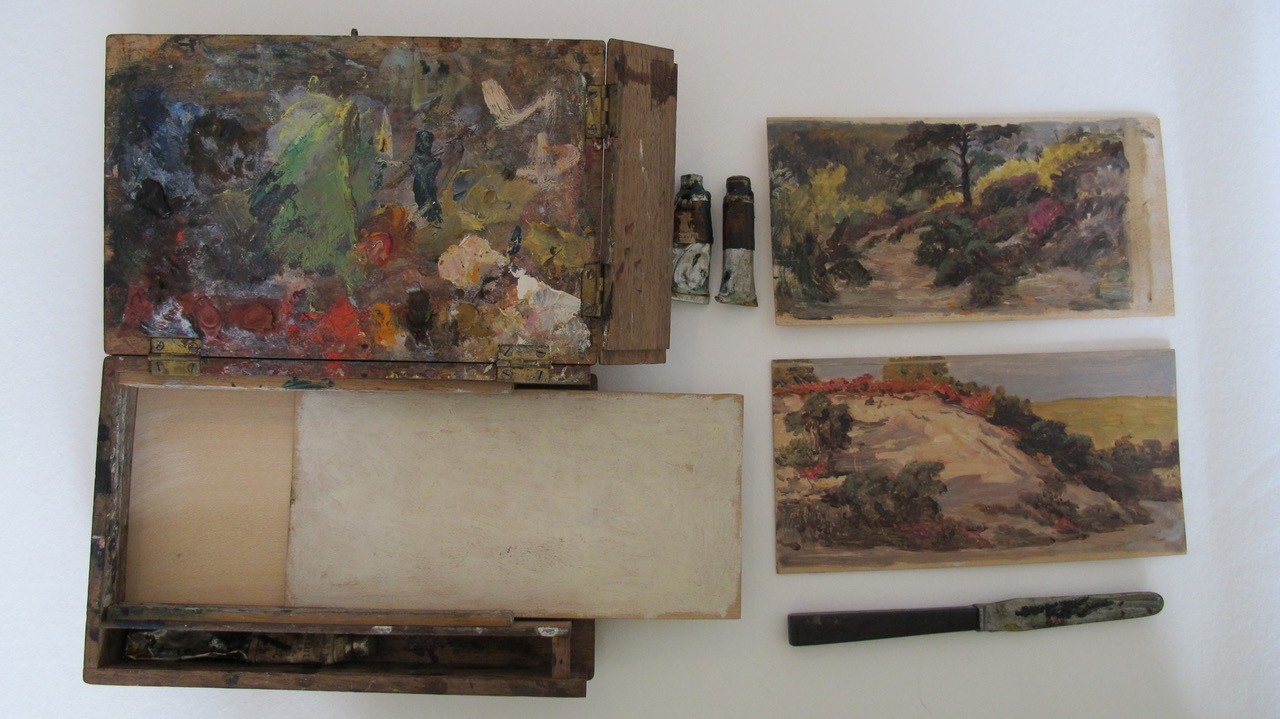
Joanna Mary Boyce’s paintboxes
Colour Materiality
1850
Joanna Mary Boyce (1831-61), was very highly regarded as both artist and reviewer in her short lifetime, particularly by the critic John Ruskin. She exhibited oil paintings at the Royal Academy, London, and like many artists in the nineteenth century, she developed some of her ideas in watercolour. Following her marriage to portraitist Henry Tanworth Wells, her contemporaries would have addressed her as ‘Mrs Wells’.
Her surviving paintbox for oil painting was designed for sketching outdoors. It is tiny, about the length of a woman’s hand, designed to hold a few small tubes of oil paint or brushes, as well as having slots to enable 5 small panels to be painted outdoors successively in one session, then carried home safely because separated in the box while the paint was still wet. Five panels are still inside, two painted, one on both sides and hence used on different occasions. When last used, the box included two small tubes of Winsor & Newton oil paints, one labelled viridian green (invented only a few decades earlier) and the other illegible now but oozing Antwerp blue-coloured paint. The larger tube from a different supplier has oozed so much honey-coloured material that it cannot be dislodged, but the contents are likely to be a megilp-type medium modifier. The tiny palette knife that fits in the slot for the paints has more of this material dried onto the blade. Boyce used the inside lid for mixing paint, and the contents of all three tubes are recognisably present here and on the painted panels, while yellow and red ochre shades and a blue are also present. The range of colours mixed on the lid looks narrow and is a good visual match to those found in her surviving paintings. From its shading, some of the green paint is mixed from yellow and blue as were most green paints used for landscape.
Boyce’s watercolour box has also survived, a quality product from Rowney the colourmen, with all the items retaining supplier’s labels purchased from the same colourman. It includes everything needed for serious work in watercolour: three graphite pencils and three coloured ones as well as seven charcoal sticks and a block of white chalk for sketching (the last would be useful on coloured paper), as well as a dainty lady’s knife folded into a tiny case, for trimming and fitting quill brush heads to brush handles. The three brushes are suitable for watercolour work: two are traditional quills and one the new metal ferrule type. The range of twelve watercolour blocks is comprehensive, and includes the vermilion, yellow ochre, emerald green, and Prussian blue that Boyce regularly used in her oil paintings too. Some broken watercolour blocks are stored in the box, indicating regular use and topping-up of its contents. It comes completely ready for use outdoors, with a small palette and a water glass. The whole box, opened, would have enabled her to start sketching or painting immediately, either seated or standing.
Bibliography
-
Bradbury, Sue (ed.), The Boyce Papers: The Letters and Diaries of Joanna Boyce, Henry Wells and George Price Boyce, Woodbridge, The Boydell Press, 2019.
-
Herrington, Katie J. T., ‘Joanna Mary Boyce: Beyond Pre-Raphaelitism’, in Katie J. T. Herrington (ed.), Victorian Artists and their World 1844–1861: As Reflected in the Papers of Joanna and George Boyce and Henry Wells, Woodbridge, The Boydell Press, 2024, pp.169–206.
-
Nunn, Pamela Gerrish, ‘Joanna Mary Boyce: In Her Own Time’, in Katie J. T. Herrington (ed.), Victorian Artists and their World 1844–1861: As Reflected in the Papers of Joanna and George Boyce and Henry Wells, Woodbridge, The Boydell Press, 2024, pp.145–168.
-
Townsend, Joyce H., ‘Paint and painting: the virtues and trials of practices exchanged by word-of-mouth’, in Katie J. T. Herrington (ed.), Victorian Artists and their World 1844–1861: As reflected in the papers of Joanna and George Boyce and Henry Wells, Woodbridge, The Boydell Press, 2024, pp.123–144.